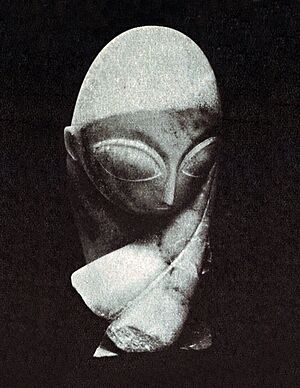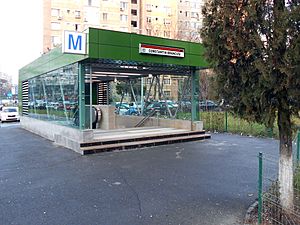Constantin Brâncuși facts for kids
Quick facts for kids
Constantin Brâncuși
|
|
|---|---|
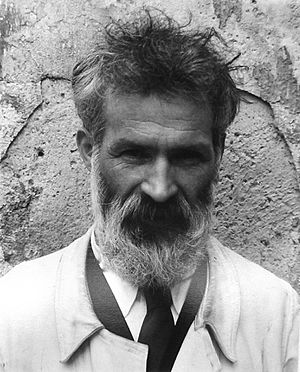
Photograph taken by Edward Steichen in 1922
|
|
| Born | February 19, 1876 Hobița, Romanian United Principalities
|
| Died | March 16, 1957 (aged 81) Paris, France
|
| Resting place | Cimetière du Montparnasse, Paris |
| Nationality | Romanian, French (naturalized in 1952) |
| Education | École des Beaux-Arts |
| Known for | Sculpture |
|
Notable work
|
|
| Movement | Modernism |
| Awards | Election to Romanian Academy |
| Patron(s) | John Quinn |
Constantin Brâncuși (born February 19, 1876 – died March 16, 1957) was a famous Romanian sculptor, painter, and photographer. He spent most of his career working in France. Brâncuși is seen as one of the most important sculptors of the 20th century and a leader in modern art. He is often called the "father of modern sculpture."
As a child, Brâncuși was very good at carving wooden farm tools. He studied art first in Bucharest, then in Munich, and finally at the École des Beaux-Arts in Paris. His artwork focuses on simple, clean shapes and lines. He balanced the natural look of his materials with deeper, symbolic meanings. Brâncuși also found ideas in art from non-European cultures, like other artists such as Paul Gauguin and Pablo Picasso. He was also inspired by traditional Romanian folk art.
Contents
Brâncuși's Early Life
Brâncuși grew up in a small village called Hobița in Romania. This area is famous for its rich tradition of folk crafts, especially woodcarving. The geometric patterns often seen in his later works, like the The Endless Column from 1918, come from this region.
His parents were poor farmers. From the age of seven, Brâncuși helped by herding the family's sheep. He was very good at carving things from wood. He often ran away from home to escape his father and older brothers.
At nine, Brâncuși left his village to find work in a bigger town. By age eleven, he worked for a grocer. Later, he became a helper in a public house in Craiova for several years. When he was 18, Brâncuși made a violin by hand using materials he found. An industrialist was so impressed by his carving talent that he helped Brâncuși enroll in the Craiova School of Arts and Crafts. He loved woodworking there and graduated with honors in 1898.
After that, he joined the Bucharest School of Fine Arts. Here, he received formal training in sculpture. He worked very hard and quickly showed great talent. One of his first surviving works is a detailed statue of a man with his skin removed to show the muscles underneath (called an écorché). This was shown in 1903. Even though it was an anatomy study, it showed his future goal: to reveal the true essence of things, not just how they looked on the outside.
Working as an Artist in Paris
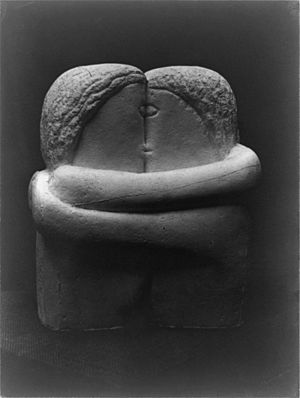
In 1903, Brâncuși traveled to Munich and then to Paris. In Paris, he found a lively community of artists and thinkers with many new ideas. He worked for two years in the studio of Antonin Mercié. He was also invited to work with the famous sculptor Auguste Rodin. However, Brâncuși left Rodin's studio after only two months. He famously said, "Nothing can grow under big trees," meaning he needed to develop his own style.
After leaving Rodin, Brâncuși began to create his unique and revolutionary style. His first paid work was The Prayer, part of a gravestone. It shows a young woman kneeling and praying. This sculpture was an early step towards his abstract style. It showed his desire to capture "not the outer form but the idea, the essence of things." He also started carving more, instead of using clay or plaster to make molds, which was common then. By 1908, he mostly carved his sculptures.
In the next few years, he made many versions of Sleeping Muse and The Kiss. He made these forms even simpler, turning them into geometric and minimalist objects.
His works became very popular in France, Romania, and the United States. Art collectors, like John Quinn, bought his pieces. Critics also praised his art. In 1913, Brâncuși's work was shown at the Salon des Indépendants in Paris and at the first exhibition of modern art in the U.S., called the Armory Show.

In 1920, he became well-known for his sculpture Princess X at the Salon des Indépendants. This sculpture was later revealed to be a portrait of Princess Marie Bonaparte.
Around this time, Brâncuși started making the bases for his sculptures with great care. He believed these bases were an important part of the artwork itself.
One of his most important series of sculptures was Bird in Space. These are simple, abstract shapes that represent a bird flying. These works were based on his earlier Măiastra series. In Romanian folk stories, the Măiastra is a beautiful golden bird that can tell the future and heal the blind. Over the next 20 years, Brâncuși made many versions of Bird in Space from marble or bronze. There are 36 known versions of these bird sculptures.
One of these Bird in Space sculptures caused a big argument in 1926. Photographer Edward Steichen bought it and sent it to the United States. Customs officers did not think the Bird was a work of art. They charged a tax on it as if it were an industrial item. After a long court case, this decision was changed. The court agreed that the Bird was a work of art and should not be taxed. This ruling was important because it helped establish that "art" does not have to look exactly like real life. It can also represent an abstract idea, like "flight."
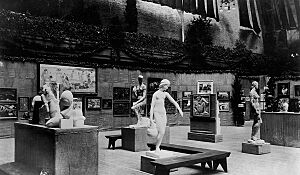
Brâncuși's work became more and more popular in the U.S., and he visited several times. In 1933, his worldwide fame led to a special request from the Maharajah of Indore, India. The Maharajah wanted Brâncuși to build a meditation temple called the Temple of Deliverance. Brâncuși went to India in 1937 to start the project. However, the Maharajah was away and seemed to lose interest, so the temple was never built.
In 1938, Brâncuși finished a monument for World War I in Târgu Jiu, Romania, where he had spent much of his childhood. This monument includes Table of Silence, The Gate of the Kiss, and The Endless Column. These sculptures honor the bravery of Romanians who defended Târgu Jiu in 1916. This group of sculptures is considered the peak of his artistic career.
In his last 19 years, Brâncuși created fewer than 15 new pieces, mostly re-working older ideas. Even as his fame grew, he became more private. Brâncuși had his first major art show in 1955 at the Guggenheim Museum in New York.
In his later years, Brâncuși was cared for by a Romanian couple. He became a French citizen in 1952 so he could leave his studio and its contents to the Musée National d'Art Moderne in Paris. This museum has rebuilt his studio exactly as it was when he died, and it is open to the public.
Brâncuși's Personal Life
Brâncuși dressed simply, which reflected his Romanian peasant background. His art studio looked like the traditional houses from his home region. It had a large stone slab for a table and a simple fireplace. He cooked his own food, often traditional Romanian dishes, which he would share with his guests.
Brâncuși had many interests, from science to music, and he enjoyed playing the violin. He would sing old Romanian folk songs, often showing how much he missed his home country. After communism came to Romania, he never returned permanently, but he did visit eight times.
His friends in Paris included many famous artists and thinkers like Amedeo Modigliani, Pablo Picasso, and Marcel Duchamp. He also stayed in touch with Romanian artists and intellectuals living in Paris.
Brâncuși was very interested in mythology, especially Romanian folk tales and traditional art, which greatly influenced his work. He also studied African and Mediterranean art.
He was a skilled handyman. He built his own phonograph (an early record player) and made most of his furniture, tools, and doorways. His way of thinking focused on "telling the important from the unimportant." He was influenced by thinkers like Plato and Lao-Tzu. He was known for being a very spiritual person, and his studio felt like a peaceful, sacred place to visitors. However, in the 1910s and 1920s, he also enjoyed a lively social life with his artist friends. He liked cigarettes, good wine, and the company of women. He had one child, John Moore, with a New Zealand pianist, but he never officially recognized him.
Death and Legacy
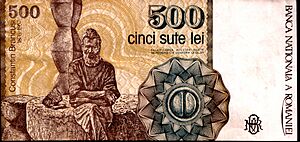
Constantin Brâncuși died on March 16, 1957, at 81 years old. He was buried in the Cimetière du Montparnasse in Paris. This cemetery also has statues that Brâncuși carved for other artists who had passed away.
When he died, Brâncuși left behind 1200 photographs and 215 sculptures. He gave part of his collection to the French government. His wish was for his workshop to be rebuilt exactly as it was on the day he died. This rebuilt studio, next to the Pompidou Centre in Paris, is now open to the public.
Brâncuși was chosen to be a member of the Romanian Academy in 1990, after his death. In 2011, Google honored his 135th birthday with a special "Doodle" showing seven of his artworks.
Brâncuși's sculptures are in many famous museums around the world. These include the National Museum of Art of Romania in Bucharest and the Museum of Modern Art in New York City. The Philadelphia Museum of Art has the largest collection of his sculptures in the United States.
In 2015, the Romanian Parliament declared February 19 "The Brâncuși Day," a special working holiday in Romania. A metro station in Bucharest is also named after him.
Brâncuși on His Art
| "I ground matter to find the continuous line. And when I realized I could not find it, I stopped, as if an unseen someone had slapped my hands." |
"Work like a slave; command like a king; create like a god." |
Famous Works
Two of Brâncuși's most famous works are Bird in Space and Sleeping Muse I. These sculptures show living things, but they are much more abstract than older art from Ancient Greece or the Renaissance.
Bird in Space is a series of sculptures from the 1920s. One version, made in 1925 from wood, stone, and marble, stands about 72 inches tall. It looks like a narrow feather standing upright on a wooden base. Brâncuși also made similar versions from bronze for art shows.
Sleeping Muse I also has different versions. One, from 1909 to 1910, is made of marble and is about 6 ¾ inches tall. This sculpture is a model of a head without a body. It has simple lines to show features like hair, a nose, lips, and closed eyes. Art experts say the sculpture has an "abstract, curving quality and a smooth outline that create an impression of elegance." You can especially see this in the shape of the eyes and mouth.
Other Artworks
- Bust of a boy (1906)
- The Prayer (1907)
- La Sagesse de la Terre (1908)
- Sleeping Muse (1910), Metropolitan Museum of Art
- Prometheus (1911)
- Mademoiselle Pogany (1912), Philadelphia Museum of Art
- Miss Pogany (1913), drawing
- The Kiss (1916), Philadelphia Museum of Art
- Princess X (1916)
- Madame L.R. (1914–1918)
- A Muse (1917)
- Chimera (1918)
- Eileen Lane (1922)
- Bird in Space (1924), Philadelphia Museum of Art
- Portrait of Nancy Cunard (also called Sophisticated Young Lady) (1925–1927)
- Le Poisson (1926)
- Portrait of James Joyce (1929)
- Le Coq (1935)
- Sculptural Ensemble of Constantin Brâncuși at Târgu Jiu (Endless Column) (1935)
- Blonde Negress I (1926), Toledo Museum of Art
- White Negress II (1928), Art Institute of Chicago
Images for kids
-
Brancusi Fish at Tate Modern
Brâncuși in Stories and Movies
- A short story from 1925 by Robert McAlmon called Distinguished Air is about an art show featuring Princess X.
- In the 1945 novel Brideshead Revisited by Evelyn Waugh, a character mentions owning sculptures by Brâncuși.
- In the 1988 movie Short Circuit 2, a character sees the robot Johnny 5 and jokes that it looks like "an early Brâncuși."
- In the 1999 science fiction TV series Total Recall 2070, an artifact called the "Brancusi Stone" looks like one of his sculptures.
- In the 2000 film Mission to Mars, the "Face on Mars" is designed to look like Brâncuși's Sleeping Muse.
See also
 In Spanish: Constantin Brâncuși para niños
In Spanish: Constantin Brâncuși para niños



